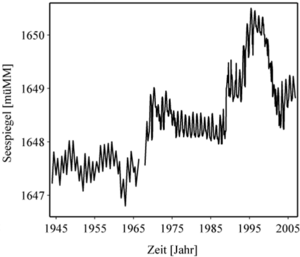
Auswirkung von Seespiegeländerungen auf die Tiefenwassererneuerung im Van See (Türkei)
Lake Van is a saline (~ 21 g kg-1) closed basin lake and the largest lake in Turkey. Because of the high salinity waters mixing conditions in Lake Van can be expected to be very sensitive to an exess of freshwater input. This project will investigate current transport and exchange processes in Lake Van and will assess the effect of changes in the hydrological regime on deep-water renewal and mixing. The study will be based on data on a wide range of environmental tracers (temperature, salinity, light transmission, dissolved oxygen, SF6, CFC-12, 3H, 3He and additional noble gases). These data will be collected during two field campaigns to Lake Van.
The recent lake level rise in Lake Van offers an excellent opportunity to study the consequences of the change in the hydrological regime on the mixing dynamics in saline lakes. In particluar this is the case because an extensive data set on tracer data from Lake Van is available for 1989 when the last phase of water level rise had just begun. Additionally, a hydrologically induced change in the mixing dynamics may effect ecosystem functioning and hence influences the signals found in sediment cores. Therefore, this project provides essential background information for the interpretation of paleo-limnological data from sediments collected in Lake Van. This is of specific importance because Lake Van has been selected as a potential site for an “International Continental Drilling Project” (ICDP) to investigate climate change based on sediments. Further, the Environmental Isotopes Group at EAWAG (Switzerland) intends to employ their recently developed techniques of noble gas analysis in pore waters to reconstruct mixing in Lake Van and paleoclimatic conditions during the Holocene (project submitted to Swiss Science Foundation SNF).
This project will be conducted in close collaboration with the Environmental Isotopes Group at EWAG which has offered the use of their laboratory for transient tracer analysis.
